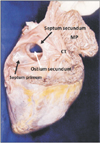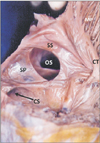Abstract
Atrial septal defect (ASD) is one of the common congenital anomalies of the heart in humans. Its complications depend on the size of the defect and can manifest at any age. The common symptoms of ASD include dyspnea and fatigue. Most of the ASDs are associated with morbidity and mortality, Earlier the treatment, it is better to the patient. I saw a large ostium secundum defect in the heart of an adult female cadaver during dissection classes for undergraduate medical students. The interatrial septum had large defect at the region where fossa ovalis should have been located. It was about 1.25 inches in diameter and oval in shape. This type of large septal defect might result in cyanosis, stroke or death of the patient at any age.
The interatrial septum is the partition between the right and left atria of the heart. It starts to develop in the fourth week of intrauterine life [1]. As the beginning of this event, first the septum primum grows down from the roof of the common atrium. The gap between it and the endocardial cushions in the atrioventricular canal is called ostium primum. As the septum primum grows down and closes the ostium primum, another opening called ostium secundum appears in the upper part of the septum primum and is known as ostium secundum. Another sickle shaped septum called septum secundum develops on the right side of the septum primum but it fails to touch the endocardial cushions of the atrioventricular canal. Thus, an oblique passage called foramen ovale connects the right and left atria till birth. At the time of birth, the septum primum and secundum fuse with each other and complete the formation of the interatrial septum. The foramen ovale normally closes within three months following birth. In about 30% of individuals, the foramen ovale doesn’t close completely but remains as a small foramen called patent foramen ovale. If the patent foramen ovale is very small, it may go unnoticed for decades together without causing any complications. However if it is very large, it might show symptoms early during childhood. I report here, the persistence of a large ostium secundum for about five decades.
During routine dissections for medical students, I found a large atrial septal defect (ASD) in the heart of a female cadaver aged approximately 50 years. The body was donated to the Department of Anatomy for teaching and research purpose. No documents were available about the cause of death and the past history about the lifestyle of woman and problems associated with this ASD. But, the cadaver had a moderate built and did not present any other obvious anomalies. While dissecting the right atrium, I observed the large oval foramen (Figs. 1, 2) which had a diameter of 1.25 inches. The partially grown septum secundum was seen separating the upper part of the atria incompletely. The septum primum was seen as a semilunar, membranous valve projecting up from the right side of the septum secundum (Figs. 1, 2). Neither the heart, nor the body of the cadaver had any other notable abnormalities.
ASDs are the abnormal communications between the right and left atria allowing the mixing up of the blood of two compartments. They are of three types; ostium secundum defect, ostium primum defect, and sinus venosus defect. The ostium secundum defect is the true defect that is seen in the region of fossa ovalis. Ostium primum defect is characterized by the presence of a common atrioventricular valve and the sinus venosus defect is associated with anomalous pulmonary venous system. Down syndrome is associated with ASDs and the offspring of patients with ASDs are at a risk of heart disease [23]. Many patients with ASDs may not present any symptoms early in life. The age at which symptoms appear is highly variable. Dyspnea and fatigue is the most common symptom in those having ASDs. Large ASDs are associated with increased morbidity and mortality [4]. They can be surgically or medically treated and the earlier the treatment, more benefit for the patient [56].
Patent foramen ovale is a condition where the septum primum and septum secundum fail to fuse after birth. Under certain hemodynamic conditions, when there is a transient pressure gradient from the right to left atria, a patent foramen ovale can open and enable blood to pass from the venous to the arterial circulation. This shunting of the blood is the mechanism of paradoxical embolism [789]. Another condition associated with the patent foramen ovale is the cryptogenic stroke which has been reported by several workers [101112].
Very large septal defect like the one being reported here would be life threatening at any age. The symptoms might appear even with a small amount of exercise and may lead to stroke or death. How the lady survived for about 50 years with such a large septal defect is a mystery. It is possible that she had symptoms like fatigue and dyspnea. She would have had a compromised life with a lazy lifestyle. She would have lead a less strenuous life to live for such a long period with such a big defect in her interatrial septum.
Figures and Tables
References
1. Sadler TW. Langman's medical embryology. 11th ed. Philadelphia, PA: Lippincott Williams and Wilkins;2011. p. 175.
2. Burn J, Brennan P, Little J, Holloway S, Coffey R, Somerville J, Dennis NR, Allan L, Arnold R, Deanfield JE, Godman M, Houston A, Keeton B, Oakley C, Scott O, Silove E, Wilkinson J, Pembrey M, Hunter AS. Recurrence risks in offspring of adults with major heart defects: results from first cohort of British collaborative study. Lancet. 1998; 351:311–316.
3. Uebing A, Steer PJ, Yentis SM, Gatzoulis MA. Pregnancy and congenital heart disease. BMJ. 2006; 332:401–406.
4. Campbell M. Natural history of atrial septal defect. Br Heart J. 1970; 32:820–826.
5. Konstantinides S, Geibel A, Olschewski M, Görnandt L, Roskamm H, Spillner G, Just H, Kasper W. A comparison of surgical and medical therapy for atrial septal defect in adults. N Engl J Med. 1995; 333:469–473.
6. Attie F, Rosas M, Granados N, Zabal C, Buendía A, Calderón J. Surgical treatment for secundum atrial septal defects in patients >40 years old. A randomized clinical trial. J Am Coll Cardiol. 2001; 38:2035–2042.
7. Choong CK, Calvert PA, Falter F, Mathur R, Appleton D, Wells FC, Schofield PM, Crawford R. Life-threatening impending paradoxical embolus caught "red-handed": successful management by multidisciplinary team approach. J Thorac Cardiovasc Surg. 2008; 136:527–528.
8. Kim RJ, Girardi LN. "Lots of clots": multiple thromboemboli including a huge paradoxical embolus in a 29-year old man. Int J Cardiol. 2008; 129:e50–e52.
9. Ahmed S, Sadiq A, Siddiqui AK, Borgen E, Mattana J. Paradoxical arterial emboli causing acute limb ischemia in a patient with essential thrombocytosis. Am J Med Sci. 2003; 326:156–158.
10. Cabanes L, Mas JL, Cohen A, Amarenco P, Cabanes PA, Oubary P, Chedru F, Guérin F, Bousser MG, de Recondo J. Atrial septal aneurysm and patent foramen ovale as risk factors for cryptogenic stroke in patients less than 55 years of age: a study using transesophageal echocardiography. Stroke. 1993; 24:1865–1873.
11. Di Tullio M, Sacco RL, Gopal A, Mohr JP, Homma S. Patent foramen ovale as a risk factor for cryptogenic stroke. Ann Intern Med. 1992; 117:461–465.
12. Handke M, Harloff A, Olschewski M, Hetzel A, Geibel A. Patent foramen ovale and cryptogenic stroke in older patients. N Engl J Med. 2007; 357:2262–2268.




 PDF
PDF ePub
ePub Citation
Citation Print
Print




 XML Download
XML Download